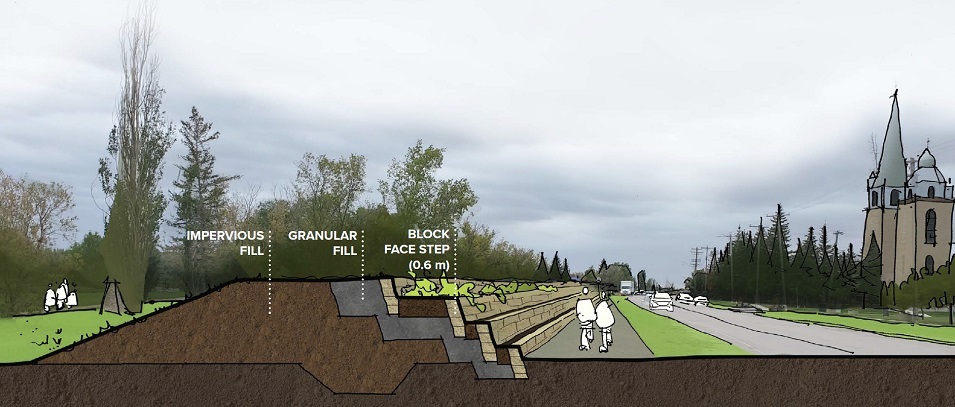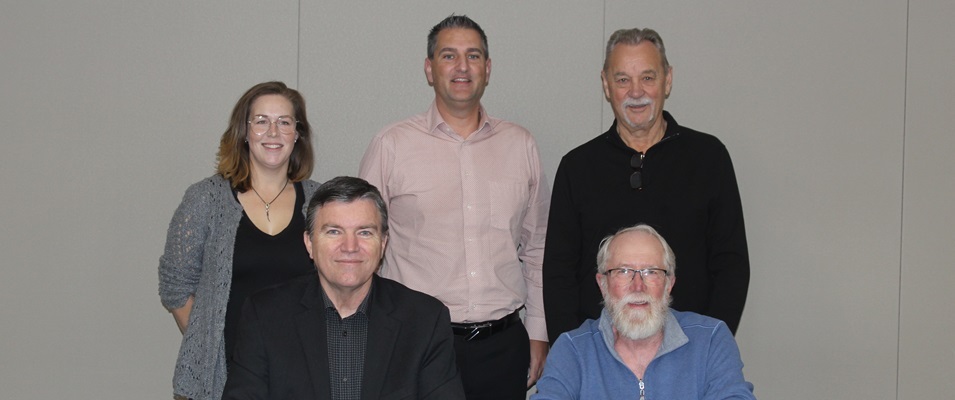
Ste. Agathe’s Culture and Community Centre was filled with residents on June 13 for the third and final public engagement session on the community ring dike-raising initiative.
Information sessions one and two, which took place in December and March, addressed the province’s intent to raise the dike to a one-in-200-year flood level. Resident feedback was sought on key concerns and desires concerning the new dike’s aesthetic.
Representatives from Manitoba Transportation and Infrastructure (MTI), KGS Group, and Scatliff, Miller and Murray (SMM) were on hand again for round three, this time introducing preliminary design solutions created as a result of the data collected.
If the project proceeds, work will begin on stabilizing the riverbank in areas where it’s needed, raising the existing earth dike as much as 1.5 meters in height, and creating new lengths of dike where none currently exist.
“Forty years ago or so, when projects like this were born, the decision-maker, I think, oftentimes was cost and budget [focused],” says Baldwin. “Here we are in 2023 and we have to think about a lot more things… as we’re designing solutions for flood protection infrastructure.”
In order to take advantage of federal grant monies, the province has set its sight on a completion date of March 2025 for this project.
Following the third public round of engagement, a preliminary design report will be submitted to the province which will set the stage for a detailed design, and eventually the tendering process.
The goal of the landscape engineers assigned to this task was to design a dike system that would protect the community well into the future with nominal input by the RM during high-water years.
“We don’t want to have to plan for maintenance in the future if we can avoid it,” says Jared Baldwin of MTI. “It’s really about playing the long game. If you do a little bit more planning now you can save in the future.”
Aside from public feedback, factors that influenced the dike design included the cost of the build, environmental impacts, and feasibility of construction within the designated timeline.
Drainage upgrades also played a major role in the decision-making process. Integrated into the design are new drainage culverts at the northeast and southeast corners of the community. As well, two new retention ponds are being proposed on the inside of the northeast dike to collect rainwater and snowmelt and direct it towards the drainage areas.
New Dike Along the Riverbank
One of the most involved sections of the dike design was the section that doesn’t yet exist. It’s the one-kilometre stretch along the riverbank on the community’s east side. This area borders private property and public space, including the local boat launch.
In session two, three different options were presented to residents for feedback. These included an earth dike similar to what surrounds the rest of the community, a mechanically stabilized earth wall dike (MSE), and a bin wall dike.
“The most expensive [dike] per lineal meter is, surprisingly and a little bit counterintuitively, the earth fill option,” Baldwin says. “That is because it requires the most amount of riverbank stabilization, which translates into rock fill. That puts the cost way up there.”
The earth fill dike also carries the greatest cost in terms of environmental impact, requiring major digging along the riverbank and the removal of some trees and vegetation.
Even so, the bin wall dike ranked the least popular option of them all, as it was the most complex to construct, had a poor safety rating, and was considered by most residents to be too industrial in appearance.
In this session, the representatives provided a fourth option: a hybrid dike consisting of both earth and MSE wall. This, they said, was an option the province asked them to consider.
This hybrid dike option ranked the highest in popularity. It was simplistic in operation and maintenance, reasonably priced, and provided the most user-friendly experience.
Impeded Views
Approximately five property owners will have their views and backyard enjoyment impeded by the new dike if it’s built. One of those property owners addressed Baldwin at the meeting, querying about the necessity of putting up a dike along this stretch in the first place.
Only three or four times in the past 25 years, she said, has it even been necessary to erect a temporary dike along this stretch.
In response Baldwin suggested that conversations such as these could be addressed during the detailed design phase.
“There will be group sessions with these owners to start talking about what options there are as far as those privately owned riverside parcels are concerned,” Baldwin says.
These private group sessions, he adds, will likely be held this coming fall. If all goes well, Baldwin is hopeful that dike reconstruction will begin next summer.


















